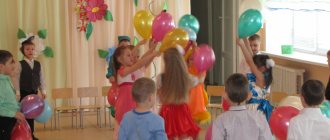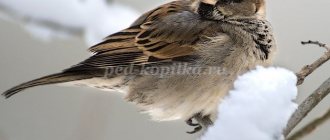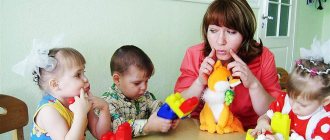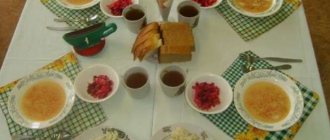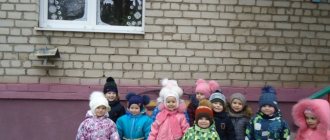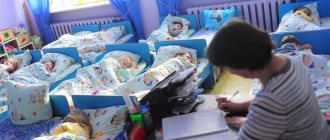Consultation "Conducting a walk in kindergarten"
Walk
Organizing and conducting walks in kindergarten.
A walk is a very important routine moment in the life of children in preschool educational institutions.
Purpose of the walk
– health promotion, fatigue prevention, physical and mental development of children, restoration of functional resources of the body reduced during activity.
Walking tasks
:
Physical development of children
– a walk is the most accessible means of hardening a child’s body, helping to increase its endurance and resistance to adverse environmental influences, especially colds.
Optimization of physical activity - while walking, children move a lot, and movements increase metabolism, blood circulation, and improve appetite. Children learn to overcome obstacles, become more agile, dexterous, courageous and resilient. They develop motor skills and abilities, strengthen the muscular system, and increase vitality.
Mental development of children -
children get a lot of new impressions and knowledge about their surroundings: about the work of adults, about transport, about traffic rules, etc. from observations they learn about the features of seasonal changes in nature, notice connections between various phenomena, and establish elementary dependencies. Observations arouse interest, questions to which they strive to find an answer. All this develops observation, expands ideas about the environment, awakens the thoughts and imagination of children.
Solving problems of moral education
– acquaintance with the hometown, its attractions, the work of adults, the importance of work for the lives of children. Familiarization with the surrounding environment helps to instill in children a love for their hometown. Kids work in the flower garden - they are taught hard work, love and respect for nature. They learn to notice her beauty. The abundance of colors, shapes, sounds in nature, their combination, repetition and variability - all this causes joyful experiences in children.
Thus, properly organized and thoughtful walks help to achieve the goals of the comprehensive development of children. Children are allowed to spend up to four hours a day outdoors. The daily routine of the kindergarten includes a daytime walk before lunch after educational activities and an evening walk after the afternoon snack. To achieve a healing effect in the summer, the daily routine provides for children to spend maximum time in the fresh air with breaks for meals and sleep.
Planning a walk.
When planning a walk, the main task of the teacher is to provide active, meaningful, varied and interesting activities for children: games, work, observations. When planning the content of a walk, the teacher provides for an even alternation of calm and motor activities of children, the correct distribution of physical activity throughout the walk. The sequence and duration of different types of activities changes taking into account specific conditions: time of year, weather, age of children and the nature of their previous activities. The content of evening walks is planned taking into account all the children’s previous activities.
Contents of children's activities during a walk. The content of children's activities during a walk depends on the time of year, weather, theme of the week, previous educational activities, interests and age.
Structure of the walk.
- Observation.
- Physical activity: outdoor games, sports games, sports exercises.
- Children's labor at the site.
- Individual work with children.
- Independent play activity.
Observation.
A large place is given to observations (pre-planned) of natural phenomena and social life. Observation can be carried out with a whole group of children, with subgroups, as well as with individual children. The teacher involves children in observations in order to develop attention and interest in nature and social phenomena. The surrounding life and nature provide an opportunity to organize interesting and varied observations. For example, you can pay attention to the clouds, their shape, color, and compare them with images known to children. Monitoring of the work of adults who work near the kindergarten, for example construction workers, should also be organized.
Physical activity. The leading place during the walk is given to games, mainly active ones. They develop basic movements, relieve mental stress, and cultivate moral qualities.
During the walk we include outdoor games:
2-3 games of high mobility;
2-3 games of low and medium mobility;
Games of children's choice.
An outdoor game can be played at the beginning of a walk if the educational activity involved children sitting for a long time. If they go for a walk after a music or physical education lesson, then the game can be played in the middle of the walk or half an hour before it ends.
The choice of game depends on the time of year, weather, air temperature.
On cold days, it is advisable to start your walk with games of high mobility associated with running, throwing, and jumping. These games help children better cope with cold weather;
In damp, rainy weather (autumn, spring), sedentary games that do not require a lot of space should be organized;
On warm spring, summer days and early autumn, games with jumping, running, throwing, and balance exercises should be played;
In hot weather, water games are played;
The use of plotless folk games with objects: ring throw, skittles; elements of sports games: gorodki, badminton, volleyball, football, hockey, etc.;
Useful games that expand children's knowledge and understanding of the environment. These are didactic games (cubes, lotto) and role-playing games (family games, astronaut games, hospital games, etc.). The teacher helps develop the plot of the game, select or create the material necessary for the game;
Outdoor games can be supplemented or replaced with sports exercises, sports games, games with elements of competition. Conduct sports entertainment. (In our kindergarten, according to the plan, physical education classes are taken outside once a week).
Labor activity of children
. The content and forms of its organization depend on the weather and
time of year.
So, in the fall, children collect flower seeds and harvests from the garden; In winter they can shovel snow and make various structures out of it.
The teacher can involve children in collecting toys and providing all possible assistance in putting things in order in the area;
It is necessary to strive to make child labor joyful, helping children to master useful skills and abilities. Labor tasks should be within the capabilities of children and, at the same time, require certain efforts from them. The teacher makes sure that they do their work well and finish what they started.
Individual work with children
. The teacher, in accordance with planning (based on the diagnostic results of children), carries out individual work on the cognitive-speech, social-personal, physical or artistic-aesthetic development of children. For example, for some he organizes games with a ball, throwing at a target, for others - balance exercises, for others, jumping off stumps, stepping over objects. Work is also carried out to develop the child’s speech: learning a nursery rhyme or a short poem, reinforcing a sound that is difficult to pronounce, etc. You can carry out art work, theatrical performances in the warm season, etc.
Each of the required components of the walk lasts from 7 to 15 minutes and is carried out against the backdrop of children’s independent activity
The teacher must guide the independent activities of children:
ensure their complete safety, teach them how to use the aids in accordance with their intended purpose, and constantly monitor their activities throughout the walk. The teacher makes sure that all the children are busy, not bored, and that no one gets cold or overheated. It attracts those children who run a lot to participate in quieter games.
The effectiveness of walks in a preschool institution is largely determined by an understanding of their significance, which consists in:
-satisfy the child’s natural biological need for movement;
- ensure the development and training of all systems and functions of the child’s body through motor activity and physical activity specially organized for this age;
-develop skills in different types of movements;
-promote the development of the child’s motor qualities and abilities;
-stimulate the functional capabilities of each child and activate children's independence;
- create optimal conditions for the versatile development of children: activation of mental activity, search for adequate forms of behavior, formation of positive emotional and moral-volitional manifestations of children.
SANPIN REQUIREMENTS FOR ORGANIZING A WALK
It is perhaps difficult to overestimate the importance of a walk in kindergarten. During a walk, children move actively, breathe fresh air, learn about the world around them, and get accustomed to work. All this is beneficial for the health, physical and mental development of children.
Sanitary standards stipulate that the daily duration of children's walks is at least 3-4 hours.
The walk is organized 2 times a day: in the first half - before lunch and in the second half - after a nap or before the children go home. When the air temperature is below -15°C and the wind speed is more than 7 m/s, the duration of the walk is reduced. The walk is not carried out at an air temperature below -15 ° C and a wind speed of more than 15 m/s for children under 4 years old, and for children 5–7 years old - at an air temperature below minus 20 ° C and a wind speed of more than 15 m/s;
During the walk, pupils are provided with physical activity and reasonable clothing depending on weather conditions, including in winter.
The reason for a child’s frequent illness cannot be directly dependent on the activities carried out in kindergarten. On the contrary, the kindergarten implements physical education and health activities aimed at strengthening the health of each child.
When organizing walks in the autumn and winter, you should:
1. Dress children in accordance with temperature conditions, avoid: - frostbite, hypothermia or overheating of the child’s body;
— getting children's clothes and shoes wet; 2. Protect children from exposure to the following dangerous factors characteristic of the autumn-winter period: - injuries during games on areas that are not cleared of snow and ice; — injuries from icicles falling from roofs, hanging blocks of snow during the thaw period; - falling from a slide, in cases where the teacher does not have insurance (provide control and direct insurance by the teacher while sliding down a slide, climbing, jumping from a hill, sports equipment, throwing); - injury: from metal or wooden stands of objects sticking out of the ground, low stumps on areas for outdoor games, injections from broken glass, dry branches, twigs on trees, bushes, splinters from sticks, boards, wooden toys, etc.; — injuries to the legs of pupils: in the presence of holes and potholes in the area, when jumping from stationary equipment without the teacher’s insurance; — injuries when sliding on an ice path; — when organizing the work of preschool children; - injuries, bruises during games with sports elements; - injuries, bruises during games on a wet and slippery surface; - injuries, bruises when sliding down ice slides, on sleds, while moving in icy conditions on slippery paths, external steps, areas not cleared of snow, ice and not sprinkled with sand; — injuries from touching metal structures with exposed parts of the body (face, hands, tongue, lips) on a frosty day; Avoid:
- infection with gastrointestinal diseases, acute respiratory infections, if the child puts dirty and cold snow or icicles in his mouth. - clear the roofs of all buildings from snow, sprinkle icicles with sand. Each teacher and all substitute teachers must teach children to recognize dangerous situations in illustrations and explain to children. Agree with the head nurse and manager about the possibility of going for a walk depending on the weather conditions and air temperature. The teacher must inspect the clothes and shoes of the pupils for compliance with weather conditions. Children should always be provided with spare things in case of bad weather, which parents bring in advance for this purpose;
Safety requirements while walking
1. It is not allowed to organize walks, work in one play area at the same time for 2 groups of pupils, the presence of parents on an evening walk 2. The teacher provides supervision, control over the calm exit of pupils from the premises and descent from the porch, do not run, do not push, when descending and ascending to the 2nd floor, hold onto the railings, do not carry large toys and objects in front of you that block the view of the path, etc.
Additional safety requirements during a walk in winter:
1. Ensure control and direct insurance by the teacher of pupils while sliding on ice paths, riding sledding;
2. Make sure that when sledding, the next child waits patiently until the child sliding in front of him reaches the end of the ramp or slide; 3. When sledding down a hill, do not allow children to sit with their backs to the slope; 4. Make sure that children do not put dirty snow or icicles in their mouths; 5. If frost and wind become stronger, take children to the kindergarten premises; Safety requirements in situations during a walk:
1. All employees temporarily replacing the teacher in the group take on the functions of rescuing children.
2. If unforeseen situations arise, it is necessary to: - ensure the safety of children; — make sure there is no dangerous situation; — inform the administration about the incident, provide first aid in case of an accident; — notify the rescue service by phone if the situation requires it. Safety requirements at the end of the walk
1. Organize a calm entry of pupils into the kindergarten premises (the 1st subgroup passes and undresses under the supervision of an assistant teacher, the 2nd - under the supervision of a teacher). 2. Clean students’ outer clothing and shoes from snow, dirt, and sand. 3. Check how the students put their clothes in the lockers. If necessary, change the pupils into dry clothes and underwear. 4. Organize hygiene procedures: visiting the toilet, washing hands with soap. 5. Ensure drying of wet clothes and shoes after rain or in winter
Types of walks in kindergarten
1. At the venue:
• on the territory of the kindergarten;
• outside the territory of the kindergarten (possible in older groups, over short distances).
2. By content:
• traditional, which includes children’s work activities (cleaning up leaves, snow, etc.), active and quiet games, etc.;
• thematic: consisting of observations and conversations on a specific topic (animals, clouds, trees, city transport, etc.), can be a street theater performance, a quest with overcoming simple obstacles - requires a pre-prepared script;
• targeted: organized exit outside the territory of the kindergarten, over a short distance (up to 2 km);
• excursion (usually a museum tour): once a month, starting from the middle group;
• hike: can be carried out 1-2 times a year in older groups.
Conclusion.
So, the process of raising children is continuous. Great potential opportunities for the comprehensive harmonious development of a child’s personality are inherent in the process of educational work with children in a walking environment. Here, like nowhere else, children are provided with unique conditions for all-round development; their needs for active movements, independent actions when getting to know the world around them, new vivid impressions, and free play with both natural materials and toys are fully satisfied. However, due to age characteristics, children themselves cannot use all the walking time with maximum benefit for their development. An adult must pedagogically correctly guide their activities.
In the process of daily outdoor games and physical exercises during walks, children’s motor experience expands and their existing skills in basic movements are improved; agility, speed, endurance develop; independence, activity, positive relationships with peers are formed
Conversation – consultation “Walking in the fresh air”
Conversation – consultation “Walking in the fresh air”
Consultation for parents “Let’s go for a walk in the park”
Author:
Efimova Alla Ivanovna, teacher of GBDOU No. 43, Kolpino St. Petersburg
Description of the material:
The conversation and excursion are devoted to the problem of preserving the environment, cultivating a sense of environmental responsibility.
This material will be useful to class teachers, biology teachers, additional education teachers, parents, and educators. A walk in the green area has a beneficial effect on the body and increases emotional mood. Goal:
to form an idea of the benefits of walking in the fresh air.
Objectives:
- to create a desire in children and adults to take walks in the fresh air; — broaden the horizons of parents and children.
Educator:
How nice it is to take a walk in the fresh air in summer.
Enjoy the beauty of nature and the fragrance of flowers. And it’s doubly nice to go out and walk as a group, with your friends and their parents. I am very glad that you, dear parents, took the time and decided to take a walk with us. But where we will all go, our children will tell us after guessing the riddle. There are few trees in the city, and everyone wants to go for a walk, going two blocks away from the avenues and highways. It's cool here among the alleys and green poplars. (Square, park) Children
answer.
Educator:
Of course, we are going to our beautiful and wonderful park.
I hope that from our walk you will all have only good memories, and you will all receive a lot of positive emotions. Parents and children
answer - they reason.
Educator:
We will go to the park on foot, so we will have to cross the road.
I suggest our guys remember the “Rules of Conduct on the Road”. answers
. — To cross the road, you need to use a crosswalk. — when crossing the road, you need to first look to the left, and at the dividing strip, look to the right. — You can cross the road when the light is green. — You can’t cross the road in front of a moving car. — If there is an underground passage, then you need to cross it. — You can’t play next to the roadway.
Educator:
Why do you think I chose our park for our walk?
Answers. Educator:
Of course, because there are a lot of beautiful flowers, trees, a huge green lawn, a pond with clean water, and of course, there is fresh air, which we all need so much.
Guys and dear parents, I hope you all remember the rules of behavior in a public place, and the rules of behavior in nature. Answers.
- You need to walk along paths and paths. - Do not be noisy. - Don't pick flowers. - Don't catch butterflies. - Don't destroy the anthill. - Don't tear the web. — Don’t pick up inedible mushrooms. - Don't light a fire. - Don't leave trash behind.
Educator:
Dear parents!
You know that walks are very important for your children. You need to spend as much time as possible outside, especially in the summer, and in a good place. You need to walk both during the day and in the evening, both in winter and in summer. You need to dress according to the season. Educator:
Well, we're ready for the trip, let's go.
So we came with you to our luxurious park. Look around. Beauty!!! Take a deep breath. Did you smell the smell in the park? The flowers in the flowerbed are fragrant. What flowers do you see? Answers. Educator:
You know, beautiful flowers, beautiful flower beds improve and lift our spirits.
So let's make flowers happy too. We are in kindergarten, and many of you have prepared poems about flowers at home. But I want you to read poems only about those flowers that you see in the park. Child:
All the flowers are in delicate velvet, Dressed in the sun, Drops of morning dew, Like gems, Burning on their leaves, Sparkling rainbow-colored, Their emerald outfit, Without losing for a long time. Marigolds have a very strong aroma, and there is their outfit in the flower beds. It's turning red until winter.
Child:
From childhood, I remember nasturtium, Not on the balcony, not on the window, As soon as the sun rises in the sky, Nasturtium blooms in the garden again. The sun walks slowly across the sky, My scarlet flower never takes my eyes off it.
Child:
What are these strange flowers called Marigolds? They look so much like daisies - Everyone wears orange shirts, They laugh all day long. All are called Calendula.
Child:
In late autumn, the farewell bonfire burns out in clusters of rowan trees, And the dahlias in the garden still burn with a bright flame.
Child:
Pansies are a flower from a fairy tale, They contain faith, hope, love. Pansies - Three-color colors, Waking up, they make you happy again
Child:
White daisy, Petals in flight, I rush with you in the palm of my hand, Like a helicopter.
Petals are a propeller, I'm flying a little. I want to give my mother a chamomile! Educator:
Do you know a lot of poems about flowers, but can you solve riddles?
Riddles are also about the flowers that grow in the park. - Beautiful flowers bloomed in the garden, They were full of colors, And autumn is just around the corner. (asters) - Golden and young, In a week he turned gray, And in two days, My head went bald. I’ll hide it in my pocket Former ... (dandelion) - Look - by the fence, the queen of the garden has blossomed. Not a tulip or a mimosa, But a beauty in thorns... (rose) - White basket - Golden bottom, There is a dewdrop in it, And the sun sparkles. (Chamomile) Educator:
Let's listen to the parents.
I’m sure they also know medicinal flowers and where to use them. Probably, many of them use flower tinctures in their households, and maybe they will tell you some interesting recipes. Parents' stories.
—
Parent:
Calendula - it is used for bruises, burns, boils.
— Parent:
Coltsfoot - used for sore throat, respiratory tract. Linden flowers are added to tea, an expectorant and bactericidal agent.
— Parent:
Plantain - applied to wounds, has an anti-inflammatory, wound-healing effect. Chamomile – antiseptic, diaphoretic, analgesic effect. Rinse hair with chamomile decoction.
Educator:
You are all great, you worked hard.
I suggest you play and name the flowers for me. We will play a game, call a flower, the next player names the flower, starting with the last letter. Both adults and children play. For example: aster, the next player calls “A” astilbe, etc. Game: “Name the flowers.” Educator:
And now the kids are playing.
Girls call flowers feminine, for example, she is mine - rose, and boys call flowers masculine - for example, he is mine - cornflower. We start the game
and remember the flowers.
Educator:
We had a good walk, played games, I hope we breathed in plenty of air. After all, fresh air prolongs our life.
Educator:
Thank you all so much for coming for a walk. I hope you enjoyed the walk. Walk outdoors more often, enjoy the beauty.
The material is posted on the website: https://ped-kopilka.ru/users/efimova3.
Organization of walks in preschool educational institutions according to Federal State Educational Standards
Pedagogical consultation for teachers
Organization of a walk in kindergarten according to the Federal State Educational Standard for Preschool Education: basic requirements
A walk is a mandatory element of the daily routine in kindergarten. The objectives of the walk are to give each child the opportunity to unwind, relieve tension after statistical, focused activities and create a cheerful mood
Meaningful activities in the fresh air are a favorite pastime of preschoolers, so the methodology for conducting a walk in a preschool educational institution according to the Federal State Educational Standard is of paramount importance. The content of walking activities is determined according to the program for introducing children to the outside world as part of calendar planning, taking into account:
1. Weather conditions (in the cold season, it is advisable to start a walk with outdoor games or performing work assignments that help maintain optimal body temperature, on rainy days - with sedentary activities that allow you to stay under the roof (games, stories, observations), on hot days - experimenting with water).
2. Previous types of activities (if the walk was preceded by active intellectual work, it is advisable to provide preschoolers with the opportunity to satisfy the age-related need for movement and throw out emotions during outdoor games, but if before going outside the children were involved in physical or musical activity, you can immediately begin observations , completing projects, developing quiet games).
The key to a useful and exciting walk that meets the requirements of the Federal State Educational Standard for Education and allows you to implement current pedagogical tasks is the use and consistent change of the following structural components of the walk:
| Mandatory structural elements of a walk | Description and recommendations |
| Observation | Pre-planned practice of observing phenomena, objects, objects, which can be carried out with a group or separate groups of children, is an important element of walking activities. The active all-round development of preschoolers is facilitated by observation of: · objects of wildlife - plants and birds on the site, animals - during walks outside the OS; · natural phenomena - the movement of clouds at different times of the year, rain, snowfall and melting; · labor of adults - janitor, driver, builder, etc. In accordance with the recommended methodology for conducting a walk in a preschool educational institution according to the Federal State Educational Standard, observations are implemented according to the following algorithm: 1. Establishing a fact (clouds are moving across the sky). 2. Formation of connections between parts of the object. 3. The accumulation of impressions obtained during observations (clouds move one after another, large clouds move slower than small ones). 4. Carrying out comparisons (clouds move in the presence of wind). 5. Summing up (in the fall the clouds move quickly, and in the summer - slowly). In order to accumulate significant life experience in children and expand knowledge about the world around them, different types of observations are carried out during a walk: 1. Short-term, designed to form primary ideas about objects and objects (what a sparrow looks like, what sounds it makes). 2. Long-term, contributing to the expansion of existing knowledge (seasonal changes in deciduous trees, stages of flower growth, the process of snow changing during the winter months). When organizing observations, it is necessary to take into account the age factor. With younger preschoolers, who are characterized by significant absent-mindedness, observations are carried out for 7-10 minutes, with pupils of the senior and preparatory groups - 15-25. Contemplation of the surrounding nature is carried out daily, with a mandatory change of objects of observation and the duration of this type of activity to maintain the high interest of the kids. |
| Physical activity (sports and outdoor games) | In order to preserve and strengthen children's health, prevent intellectual stress and develop moral qualities, when organizing walks in kindergarten, according to the Federal State Educational Standard, a significant place is given to play activities, namely: · outdoor games associated with running, jumping, throwing objects, avoiding obstacles, maintaining balance; · folk games; · games with elements of sports activity (relay races, small towns, dribbling the ball according to the rules of basketball); · playing with water; · sedentary games with an intellectual component (guessing an object by description, searching for general characteristics). When organizing play activities during a walk, it is important for the teacher to take into account weather conditions, age factor and time spent in the fresh air. Duration of outdoor games: · on a morning walk it is 6-10 minutes for pupils of the junior group, 10-15 for the middle group and 20-25 for the senior and preparatory groups; · on an evening walk - 10-15 minutes for younger preschoolers, 12-15 minutes - for older children. To ensure maximum activity of pupils, the content of physical activity is selected taking into account age-related skills: · with children of the younger group, it is recommended to play games with text accompaniment, involving repetition of the same type of actions; · middle group - role-playing games with preliminary preparation; · senior and preparatory groups - sports competitions, relay races, story-based entertainment games. The physical activity cluster ends with a gradual decrease in the level of activity through sedentary activities. Current methodological recommendations provide for the need to learn 3-4 new games with students every month with their subsequent repetition. |
| Individual work in various areas of development | In order to provide optimal conditions for harmonious age-related development during the walk, the teacher conducts short individual classes of cognitive, speech therapy, physical, social and personal orientation. Individual work with students is reflected in an individual plan; it may include conversations, games with various objects, learning tongue twisters, and performing exercises to develop dexterity, attentiveness, and balance. The teacher prepares the materials and equipment necessary for conducting individual pedagogical work in advance. |
| Labor activity | Planning the work activities of preschoolers while spending time in the fresh air is an important component of the methodology for conducting walks in preschool educational institutions according to the Federal State Educational Standard. Provided that work assignments are feasible, exciting and varied, this type of activity helps to unite the children's team and develop significant skills - determination, readiness for mutual assistance, responsibility, initiative. Work activity during a walk can be organized through: · Carrying out individual work assignments - this form of work takes time, but is suitable for children of all age groups; · work in groups; · collective work. Taking into account age, labor activity in kindergarten groups is implemented as follows: 1. The teacher gives the pupils of the junior group simple instructions, including 1-2 actions (bring one flower and a leaf for the herbarium). Children work in close proximity, but there is no relationship of interdependence. Group activities are completely controlled by the teacher. 2. The teacher pre-divides the children of the middle group into subgroups, pronouncing the tasks and features of their implementation for each, after which he systematically controls the quality of the work of each “work group”. 3. Children of senior preschool age are given a task, after which the teacher initiates a collective discussion of the procedure, helps in the distribution of roles, while the children independently implement the assigned work task with little help from the teacher. |
| Independent activity | Independent walking activities of children are organized under the supervision of a teacher with full safety ensured. This element of the walk promotes the development of initiative, communication skills, and the use of various types of aids, taking into account their purpose. |
It should be noted that the procedure for implementing the structural elements of a walk, the duration of which (with the exception of independent activity of preschoolers) should not exceed 7-15 minutes, can be varied by the teacher, taking into account weather conditions, daily routine, well-being and mood of children and other factors. When conducting walking activities, it is important for a responsible teacher to pay special attention to children with little initiative, who have a reduced need for physical activity, and pupils with disabilities, in order to prevent prolonged stay in the fresh air without movement, which carries high health risks.
The need to rethink the established traditions of preschool education, dictated by changes of a social nature, determines the advisability of conducting various types of walks in kindergarten according to the Federal State Educational Standard of Preschool Education. In addition to walking activities organized using established structural components, the active comprehensive development of pupils is facilitated by:
1. Walk-event
2. Entertaining walk with a character
3. Sports walk
4. Walk - labor action
5. Walk - hike
Types of walks with children that teachers can take in the summer
| Peculiarities | Recommendations on how to organize |
| Entertaining walks with a character | |
| Goals of walks and entertainment Emotionally and psychologically relieve children, create a positive emotional background, satisfy the needs for physical activity. Content Such walks can be varied and variable, depend not only on the goals and objectives set, but also on the thematic focus and semantic richness. Result Walking with a character motivates children to a certain type of activity, help to interest all children in the group, involve them in joint play activities, observations, work | Plan a walk with your character in advance and think through its scenario in detail. Focus on the outdoor leisure scenario, since the scenario for this type of walk is similar to it. Play the game with the character several times, if the kids liked it. At the same time, some pupils can engage in independent play activities. In younger groups, use character toys: rubber, bibabo and others of your choice. Use toys that are new to children to spark their interest. In younger groups, play the role of the character yourself, speak for him in order to involve children in joint gaming activities. In a group of senior preschool age, it is better to give the role of the character to a teacher of another group, a parent or a senior preschooler from another group |
| Walking events | |
| Goals of the walk-event To promote the mental, moral, aesthetic education of preschool children, to develop their curiosity. Content The walk is dedicated to a specific topic that is associated with all types of children's activities. For example, Children's Day. You can dedicate this walk to an event in kindergarten. For example, they brought and installed a new playground and sports equipment, and updated the sand in the sandbox. Result A walk-event enriches the knowledge of pupils, expands their understanding of the world around them, satisfies their need for experiences and experiments, develops creativity, maintains interest in the walk as a routine moment and creates a desire to go for a walk. Helps the teacher emphasize the importance of the event, clarify the children’s knowledge, and find out the nature of perception of a certain topic | Carry out a walk-event with children of junior and senior preschool age. Announce the walk - hang an announcement or poster in the locker room for children about the upcoming event. Think about the conditions for the walk in advance. Use a variety of outdoor materials to keep children interested in the walk. Go through the children’s route yourself and determine where it will be convenient to stop for observation, where you can play an outdoor game with the students, etc. Include in the walk-event: an organizational moment - to unite the children's team, a conversation about the upcoming event; introduction to the topic of the walk - introduction to the event; outdoor and didactic games, children's experimentation, etc.; independent creative activity of children. Plan the number of such walks taking into account the characteristics of the children's group, social events and interesting dates, but not often |
| Sports walks | |
| Purpose of sports walks Strengthen the health of preschool children, help prevent fatigue, physical and mental development, and help optimize children's motor activity. Content Sports outings are not as strictly structured as sports events and entertainment. They provide students with freedom of choice and allow them to take into account their interests and desires. Sports walks include a variety of elements of children's sports-themed activities. The emphasis should be on developing physical qualities in children, nurturing an interest in sports and a healthy lifestyle. At the same time, a sports walk cannot be filled only with motor activities. It is also recommended to include cognitive and sports-oriented tasks. The scenario for the sports walk is drawn up by the physical education teacher together with the group teacher. Pupils play together during a sports walk with a teacher or physical education teacher. Depending on the weather conditions, children’s physical activity during a walk can be of varying intensity so that they do not become overcooled or overheated. The teacher determines this before going for a walk, taking into account weather conditions. Result When properly organized, sports walks have a hardening effect on the child’s body in natural conditions and increase the level of physical fitness of preschoolers | Take exercise walks at least once or twice a month. Plan your sports walk scenario in advance. Include in the walk script: an organizational moment or an introductory conversation; outdoor, sports games; sport exercises; independent activities of children; individual work in various areas of development of students; summing up the walk, creative task. Allow at least half of the entire walk for sports games. During your walk, alternate tasks with high physical activity and games of low mobility, team games and subgroup, individual exercises. During your walk, maintain a balance between motor activities and cognitive and sports-oriented tasks. For example, these could be didactic games, games for attention, imagination, literary tasks (riddles, counting rhymes, poems). Consider children’s experience of using objects: racket, ball, jump rope, etc. Introduce children to various sports and athletes during the walk. Organize a targeted walk with your children to a stadium (city, school, courtyard) to watch how athletes or schoolchildren are engaged (if there is no ban on leaving the territory of the kindergarten due to quarantine measures). Organize a variety of outdoor games of a plot nature, which include basic movements, with children of primary preschool age during a sports walk. Build simulated sports grounds where older students will play with younger ones, give them motor tasks, and teach them certain motor skills. Conduct conversations with older preschool children about the history of the development of sports, ancient and modern sports games, and the Olympics. Organize thematic role-playing games in which students can try on the roles of a commentator, judge, spectators, athletes, ticket sellers, etc. Gradually, starting with the older group, introduce into the walk scenario team sports games adapted for preschool age: pioneer ball, football, volleyball, tennis, etc. |
| Walks – labor actions | |
| Purposes of walks - labor actions The purpose and objectives of such walks are determined by the teacher in accordance with the acquired skills and work abilities of the pupils, as well as their physical capabilities. Content Walks - labor actions - are specially organized subject-based practical labor activities of children limited in place and time. The peculiarity of such walks is the predominance of work assignments and different organized forms of work on the street in accordance with weather conditions, without reducing the overall motor activity of children. Several types of work assignments that replace each other sequentially during the walk and at the same time logically connected with each other, avoiding tiredness of children. Result Preschoolers are introduced to different forms of work in accordance with the season and weather conditions. Children start understand that working in nature is not a game or entertainment, but a serious activity. The teacher instills in them a desire to participate in caring for plants, feeding birds, cleaning the area (cleaning the veranda of sand, leaves, etc.). Children learn to work collectively | Carry out walks and labor events regularly, but not more than two or three times a month. A significant amount of time must be devoted to work activities. Organize such walks on the territory of the kindergarten, taking into account the season. Include in your walk observations, for example, of seasonal changes in nature, the growth and development of plants, the arrival and migration of birds, human labor in nature, and joint work with children. Be sure to evaluate the work done at the end of the walk. Plan work assignments for each child, taking into account his capabilities and individual characteristics during the walk. The load should be feasible. Alternate several types of work assignments, change them consistently during the walk, maintaining a logical connection between them. Include surprise moments in your walk: an unexpected task for children, a meeting with a fairy tale character or your favorite hero, watching a janitor at work. Involve younger preschoolers on walks to carry out simple tasks: sowing large flower seeds, planting onions, watering plants in the beds, picking vegetables. Give students in the middle group independent assignments. For example, they can loosen the soil, care for plants, grow vegetables and flowers on the plot together with you: clear the soil of stones and sticks, water beds, flower beds, and collect vegetables. Instruct older preschoolers to loosen the soil, water, weed, thin out and tie up plants, and harvest. Teach preschoolers how to properly use a shovel, scoop, rake, and watering can. Make sure that the maximum time allotted for labor activities for older preschoolers does not exceed 30–40 minutes. Organize children’s work activities during a walk in the morning or evening, and not during the hottest hours of the day. Make sure that materials and tools for child labor during walks comply with hygienic requirements and rules for protecting the life and health of children. Do not give children anything to work with that could create a traumatic situation or adversely affect their health and physical development |
| Walking tours | |
| Goals of the walk A hike is one of the types of walks, during which teachers solve health problems, improve motor skills and physical qualities of children. Content This is a special type of walk that differs from the traditional one in form, content and unusual organization. Teachers organize walks with children in the forest, park, square, as well as in the green area on the territory of the kindergarten. Walking trips require serious preparation of the teacher and the children. Result During the hike, children satisfy their cognitive needs, learn to love nature and see its beauty. Such walks add variety to the usual life of preschoolers | Take walks and hikes with older preschool-age children. At this age, children are quite independent, and friendly relationships develop between them. Prepare your children in advance for the hike. Plan no more than two or three such walks during the school year. First, organize a walk-hike on the territory of the kindergarten. Take a walk outside the kindergarten territory when the children are ready for it and there are no restrictions. Organize preliminary work with your children before the hike. Include a conversation, relay games, reading fiction and watching tourism videos. Introduce the pupils to the attributes necessary for a hike: tent, backpack, bowler hat, sleeping bag, etc. Start the walk-hike with an organizational moment: gather all the children, conduct a roll call and briefing, even if the walk is planned on the territory of the kindergarten. Organize short stops for rest and observation of interesting objects while the group is moving to a halt. Include a surprise moment in your hike: an unexpected meeting or an interesting task for preschoolers. Choose a convenient place for the final destination of the hike - a rest stop, where you can put up a tent, make a fire, and organize games. Play games during breaks and rest that will stimulate cognitive and intellectual activity of children, outdoor and sports games. Provide students with the opportunity to show independence and experience for themselves all the difficulties in organizing everyday life during a hike, for example, ask them to help set up a tent. Involve children in cleaning up the area at the end of the break. Organize short stops for rest and observation on the way back |
Next, practical work is carried out with teachers to develop mini-notes of the following types of walks: Walk-event; An entertaining walk with a character; Sports walk; A walk is a labor action; Walk - hike. Practical work is carried out using the “World Cafe” technology.
Given the importance of maintaining high cognitive interest among a generation of children growing up in a rapidly changing world, the teacher has the right to actively experiment with forms of walking activities, maintaining the mandatory structural components of a walk - the organized activity of preschoolers under the guidance of a teacher, the interaction of children without the intervention (but under the control) of an adult , child self-employment. An equally important point is to maintain an optimal balance between play and other types of activities, due to the fact that the first, as the main way for children to get to know the world, should remain a priority.
